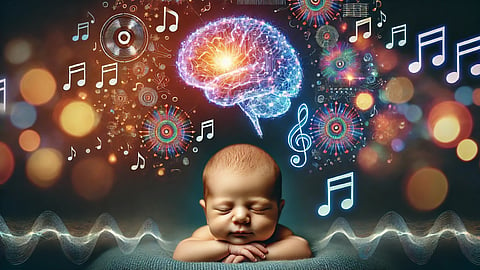

A recent study by researchers, including developmental psychologist Yasuyo Minagawa from Keio University and psycholinguist Jutta Mueller from the University of Vienna, shows that newborns can detect complex sound patterns that resemble language rules.
This finding suggests that our brains are naturally equipped from birth to recognize and process non-adjacent sound patterns- patterns where elements don't appear directly next to each other but still form rules important for language learning, as many languages contain such patterns.
How the study was conducted?
The researcher used near-infrared spectroscopy (NIRS) to monitor the brain activity of newborns and six-month-old infants as they listened to a sequence of tones. These sound sequences followed specific patterns, with some being "correct" (matching the learned pattern) and others "incorrect" (violating the pattern). By analyzing the brain's response to these sequences, the researchers aimed to identify whether infants could discern between correct and incorrect patterns based on their innate ability to detect non-adjacent sound relationships.
Key Findings
Newborns can detect non-adjacent acoustic patterns, a critical skill for language development.
Language-processing areas in the brain respond to sound sequences from birth.
Activation of Language-Related Networks in Brain: "The frontal cortex located just behind the forehead, is important for newborns," says Yasuyo Minagawa from Keio University in Tokyo. The inherent ability activates language-related neural networks, especially in the left hemisphere, laying a foundation for future language skills.
These networks become more specialized in six months, highlighting how auditory experiences influence brain development.
Significant early auditory exposure suggests that musical interventions for infants could support language development, especially for those in under-stimulating environments.
The study suggested that the brain can respond to complex patterns, such as those found in language, from day one
Jutta Mueller, University of Vienna’s Department of Linguistics
Importance of Early Learning Experiences
The connection formed between the brain regions during the learning process in newborns suggests that early learning experiences are crucial for developing the networks that later support processing complex acoustic patterns.
These insights are essential for understanding how environmental stimulation influences early brain development, particularly for infants who lack, inadequate, or poorly process stimulation, such as premature babies.
This emphasizes how non-linguistic acoustic signals, like the tone sequences used in the study, activate language-relevant brain networks. This opens up exciting possibilities for early intervention programs using musical stimulation to promote language development.
As the study continues to uncover the complexities of infant cognition and language learning, it stands as a testament to newborns' remarkable capabilities and the essential role of early sound exposure in fostering language development.
Reference:
Cai L, Arimitsu T, Shinohara N, Takahashi T, Hakuno Y, Hata M, Hoshino EI, Watson SK, Townsend SW, Mueller JL, Minagawa Y. Functional reorganization of brain regions supporting artificial grammar learning across the first half year of life. PLoS biology. 2024 Oct 22;22(10):e3002610.
(Input from various sources)
(Rehash/Josna Lewis/MSM)
